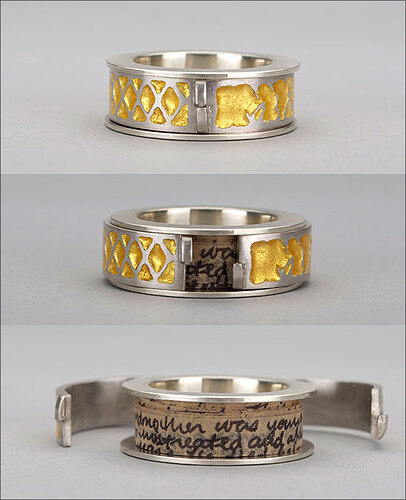Materials: sterling silver, gold foil, enamel, handwritten note
Photo credit: Ashley Gilreath
Ashley Gilreath
Gatlinburg, TN. USA
Having thoroughly researched my family’s past, whether through taped interviews of elderly members or digging through generations old documents, I investigate the lost biographies of those who came before me. The everyday experiences they shared interested me the most, and how they interacted with the objects whose lives intersected their own. My work has evolved into a collection of reliquaries and time capsules; containers used to record, display, and reconstruct the lives of my family members. I see myself as the historian, the curator and sole executor of my genealogical heritage. Through excavation and research of family artifacts, I ultimately seek to preserve the individual’s hidden narrative within my pieces.
I am not a production artist, and I relish the time it takes to make my work. Painstakingly enjoying each small detail that I adorn my pieces with, I sometimes take months to consider the implications of a pattern or mark upon the metals’ surface. I find no pleasure or intellectual stimulation in constantly producing the same work over and over, like most jewelry artists, nor does this mass production give my work a sense of timeless intimacy.
These containers and vessels definitely hold their place in the world of stunning art objects as well as in the world of metalsmithing.
Since the dawn of time humans have created containers to hold things that were important to them, from large vessels to hold food and harvests to intimate containers for small precious things. They might hold memories, ashes, medicine, beverage, fruit or food - but all spring from the imagination and skill of the maker. Some have specific religious functions, some are meant for everyday use. When one thinks of a vessel or container the inclination is to think of something with solid walls - yet many of these works involve the exploration of positive and negative space, and the use of negative space to help create the illusion of the wall of the vessel.
As the world’s largest jewelry related internet site, Ganoksin strives to develop exhibitions showcasing work from around the world. This exhibition was open to all metalsmiths, professional and amateur, advanced and beginner. Participants are from The Netherlands, the USA, Canada, Australia, Costa Rica, the United Kingdom, Israel, Hong Kong, Colombia, Romania, Italy, Ireland, Japan, Malaysia and Denmark. While most of the pieces are by an individual metalsmith, some are collaborations, one of three artists spanning 50 years.
In total 319 artists contributed 729 show pieces for the permanent online exhibition.
Objects in the exhibition include boxes, lockets, urns, ash containers, bowls, wine cups, reliquaries, match holders, vases, teapots, pitchers, sugar bowls, baskets, nests, pillboxes, clutches and a range of sculptural forms. A variety of techniques are showcased covering a wide range of metalsmithing techniques. Materials used include everything from gold and silver to less expensive metals. Ornamentation includes the addition of enamel, chasing and repousse’, gemstones and found objects.
The exhibition was curated by Beth Wicker, President of the North Carolina Society of Goldsmiths in the United States, and Adjunct Instructor at Northeastern Technical College in South Carolina. Director of the exhibition is Hanuman Aspler, founder of The Ganoksin Project, the world’s largest internet jewelry site.
